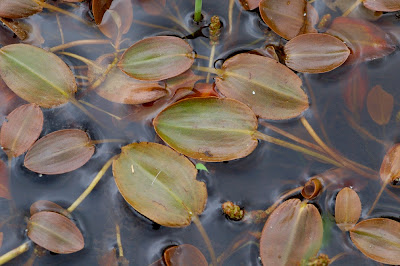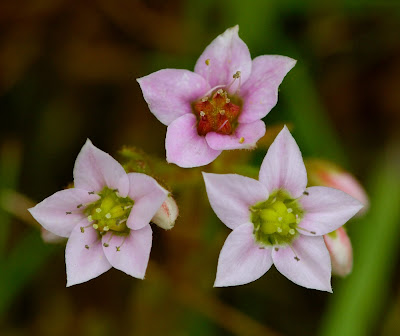Today I walked to the Hidden Valley aka the Haw Craig cliffs to be absolutely sure that there are no Badgers in the area - I've always hoped to see Badgers in the Kilpatrick Hills but there doesn't seem to be any, whether due to lack of suitable habitat or persecution (or both).
The Haw Craig valley is a great spot - very secluded and quiet! No one ever seems to venture down there and the boulder scree is a nice sun-trap.
On my way up to the Haw Craig cliffs the road was fringed with flowering thistles and I stopped to take some quick photos. The three most common species in this area are: Creeping Thistle (Cirsium arvense), Marsh Thistle (Cirsium palustre) and Spear Thistle (Cirsium vulgare).
Here's how to identify them! Firstly, the Creeping Thistle (Cirsium arvense):
The Haw Craig valley is a great spot - very secluded and quiet! No one ever seems to venture down there and the boulder scree is a nice sun-trap.
On my way up to the Haw Craig cliffs the road was fringed with flowering thistles and I stopped to take some quick photos. The three most common species in this area are: Creeping Thistle (Cirsium arvense), Marsh Thistle (Cirsium palustre) and Spear Thistle (Cirsium vulgare).
Here's how to identify them! Firstly, the Creeping Thistle (Cirsium arvense):
2.jpg) |
| Creeping Thistle (Cirsium arvense) |
.jpg) |
| Creeping Thistle (Cirsium arvense) |
The Creeping Thistle can be easily distinguished by its pale lilac flowers and the lack of spines on the stems. The flowers have a strong, honey-like fragrance.
Next, the Marsh Thistle (Cirsium palustre):
Next, the Marsh Thistle (Cirsium palustre):
5.jpg) |
| Marsh Thistle (Cirsium palustre) |
This species has dark purple flowers, spiny-winged stems, and the flower bracts are short-spined and purplish. The florets (petals) are longer than those of the Creeping Thistle.
Lastly, the Spear Thistle (Cirsium vulgare):
.jpg) |
| Spear Thistle (Cirsium vulgare) |
The Spear Thistle has significantly larger flowers than the previously mentioned species and the flowers are purplish-magenta in colour. The stems are spiny-winged and the flower bracts are green and long-spined. The flower is very globe-shaped.
The roots and peeled stems of these thistles are edible when cooked and are supposed to taste similar to Jerusalem Artichoke. I don't know whether they'd be worthwhile harvesting though (by the time you remove all the spines and roughage).
Also flowering along the Humphrey Road were Upright Hedge Parsley (Torilis japonica), Meadowsweet (Filipendula ulmaria) and Sneezewort (Achillea ptarmica).
The roots and peeled stems of these thistles are edible when cooked and are supposed to taste similar to Jerusalem Artichoke. I don't know whether they'd be worthwhile harvesting though (by the time you remove all the spines and roughage).
Also flowering along the Humphrey Road were Upright Hedge Parsley (Torilis japonica), Meadowsweet (Filipendula ulmaria) and Sneezewort (Achillea ptarmica).
.jpg) |
| Sneezewort (Achillea ptarmica) |
Sneezewort (Achillea ptarmica) is related to Yarrow and the entire plant is highly aromatic. The scientific name refers to the use of the dried, powdered leaves as a sneezing-powder (ptarmicus = to cause sneezing).
I sat down on the edge of the Haw Craig cliffs to watch the Buzzards (Buteo buteo) soaring in the sunshine. I lay down in the grass and they circled low overhead - to see what I was up to. It was amazing to sit there with my flask of coffee and some chocolate and just watch these handsome birds enjoying the air.
I sat down on the edge of the Haw Craig cliffs to watch the Buzzards (Buteo buteo) soaring in the sunshine. I lay down in the grass and they circled low overhead - to see what I was up to. It was amazing to sit there with my flask of coffee and some chocolate and just watch these handsome birds enjoying the air.
9.jpg) |
| Buzzard (Buteo buteo) |
2.jpg) |
| Buzzard (Buteo buteo) |
1.jpg) |
| Buzzard (Buteo buteo) |
3.jpg) |
| Buzzard (Buteo buteo) |
+6.jpg) |
| Buzzard (Buteo buteo) |
The grasses are looking gorgeous right now, in shades of gold, mauve and pink. They have such a subtle beauty which is often overlooked. The more I look at grasses, the more I realise that there are so many species - I wish I had a book to identify them.



All around me, the air was filled with the soft chorus of churring grasshoppers, safely hidden in the grasses. One frequently encountered species is the Common Green Grasshopper (Omocestus viridulus) - it produces a sound somewhat like 'an approaching moped' (Collins Guide to the Insects of Britain and Western Europe: Michael Chinery).
.jpg) |
| Common Green Grasshopper (Omocestus viridulus) |
A female Common Darter (Sympetrum striolatum) landed briefly on a stone but moved off before I was able to photograph her.
.jpg) |
| Bramble (Rubus fruticosus) |
Fighting through the dense undergrowth in the Hidden Valley was very arduous, to say the least.
Head-high Bracken, powerful Bramble vines snaking around my legs and holding me fast with their barbarous blood-letting thorns, ridiculously tall Stinging Nettles threatening to burn my eyes and face at every turn, inch-long woody Hawthorn spines raking my face and catching in my hair, and finally - treacherous, ankle-breaking boulder-scree, disguised with thick plant growth.
Nearer the bottom, the undergrowth and boulders disappeared and the going was easier. At this point the forest is mainly mature Sycamore trees. No evidence of any Badgers, sadly.
At the very bottom, not far from Bowling, I sat in a small clearing (can't be far from the main road). In the grass there were Wild Strawberries (Fragaria vesca) with tiny sweet red berries.
Head-high Bracken, powerful Bramble vines snaking around my legs and holding me fast with their barbarous blood-letting thorns, ridiculously tall Stinging Nettles threatening to burn my eyes and face at every turn, inch-long woody Hawthorn spines raking my face and catching in my hair, and finally - treacherous, ankle-breaking boulder-scree, disguised with thick plant growth.
Nearer the bottom, the undergrowth and boulders disappeared and the going was easier. At this point the forest is mainly mature Sycamore trees. No evidence of any Badgers, sadly.
At the very bottom, not far from Bowling, I sat in a small clearing (can't be far from the main road). In the grass there were Wild Strawberries (Fragaria vesca) with tiny sweet red berries.
.jpg) |
| crab-spider (Xysticus cristatus) female |
.jpg) |
| Enchanter's Nightshade (Circaea lutetiana) |
.jpg) |
| Self-heal (Prunella vulgaris) |
Self-heal is a small plant with deep plum-purple flowers and is frequently found in meadows/lawns. The common name suggests that it was used traditionally to treat ailments of some kind - it is edible and the bitter leaves can be eaten raw or made into a tea.
I walked back up through the forested valley to look for fungi and the Buzzards of Haw Craig followed me - mewing loudly.
I walked back up through the forested valley to look for fungi and the Buzzards of Haw Craig followed me - mewing loudly.
.jpg) |
| Dead Moll's Fingers (Xylaria longipes) |
I found a Sycamore log which was absolutely covered with huge Dryad's Saddles (Polyporus squamosus). They are an edible species but are said to have little taste and older specimens are very tough and chewy. I am thinking about collecting some as I'd like to try batter-frying them...
2.jpg) |
| Dryad's Saddle (Polyporus squamosus) |
3.jpg) |
| Dryad's Saddle (Polyporus squamosus) |
.jpg) |
| Harebell (Campanula rotundifolia) |
The sky started to darken so I headed home. Back in Glasgow, I found a male Poplar Hawkmoth (Laothoe populi) in my kitchen - the second this year (we don't get many moths in the city so I was excited!). I rescued him before any squeamish flatmates were shocked at the discovery of a 'monster-moth'!
.jpg) |
| Poplar Hawkmoth (Laothoe populi) male |
2.jpg) |
| Poplar Hawkmoth (Laothoe populi) male |
+7.jpg) |
| Poplar Hawkmoth (Laothoe populi) male |
+3.jpg) |
| Poplar Hawkmoth (Laothoe populi) male |
6.jpg) |
| Poplar Hawkmoth (Laothoe populi) male |























.jpg)













